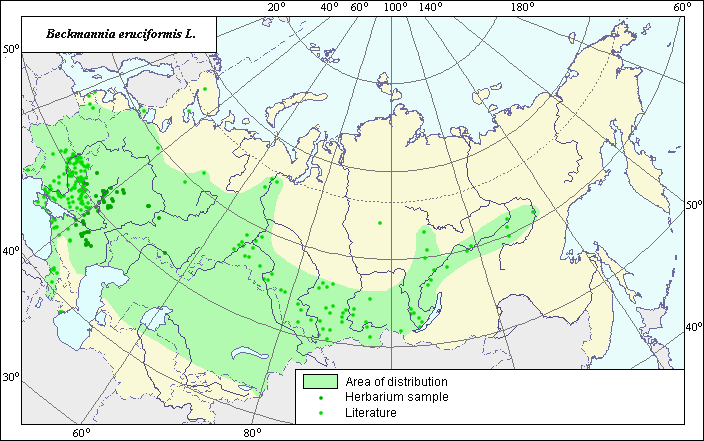Relatives
Area of Beckmannia eruciformis (L.) Host.
 Object description Download GIS-layers
Object description Download GIS-layers
Author:
V.G.Funtova.Data of creation:
28.10.2003.Scale:
1:20000000.Accuracy of the map:
The map was created using maps that had scales 1:50000000, 1:30000000, 1:10000000, 1:5000000.Projection:
Alber's Equal Area Conic for Russia, 9, 1001, 7, 100, 0, 44, 68, 0, 0.Basic contents:
Vector map. Area of species distribution is shown by polygons, actual location occurrence is shown by points.Accuracy of classifier:
Point data were obtained from literature sources and herbarium specimens. Polygons are based on literature sources, herbarium samples, and field surveys by the authors. Light-colored points represent locations of species that were determined according to literature. Dark-colored points represent locations of species that were determined according to herbarium specimens cited below.Method of map production:
Published literature was reviewed, including Atlases, monographs and papers. Occurrence data were obtained from herbarium specimens, floras, monographs and papers. Distribution point area includes locations of species from the following literature sources: Tolmachev (1974), Grossgheim (1939), Malyshev & Peshkova (1990), Shelyak-Sosonko (1977), Hulten & Fries (1986); as well as specimens from the herbariums cited below. Polygon areas were made using data about distribution of species in floristic regions from the following sources: Tolmachev (1974), Tzvelev (1976), Pavlov (1956), Hulten & Fries (1986). Polygon area is a result of integrating polygon maps accordingly: the west border by the state border of Russia; the east border by data from Malyshev & Peshkova (1990); the south border by data from Grossgheim (1939), Tzvelev (1976), Pavlov (1956) and Hulten & Fries (1986); the north border by point locations and borders of polygon maps. Several points were not included in polygon area as they could represent invasion. Data were then compiled through scanning and geo-referencing to develop a composite vector map. The biologist, together with the GIS specialist, drew a new plant distribution area based on compiled data.Reference citations:
Grossgheim A.A. 1939. Flora of the Caucasus. Baku. V. 1: 402. In Russian.Hulten & Fries. 1986. Atlas of North European Vascular Plants North of The Tropic of Cancer. Konigstein. V. 1-3: 1172.
Malyshev L.I. & G.A. Peshkova, ed. 1990. Flora of Siberia. Poaceae (Graminea). Novosibirsk: Nauka. V. 2: 361. In Russian.
N.I. Vavilov All-Russian Institute of Plant industry [WIR], St. Petersburg, Russia.
Pavlov N.V., ed. 1956. Flora of Kazakhstan. Alma-Ata: Publishing House Acad. Sci. Kazakhstan SSR. 354 pp. In Russian.
Rostov Botanical Garden, Rostov State University [RWBG], Rostov-on-Don, Russia.
Shelyak-Sosonko, Y.P., ed. 1977. Poaceae Ukraina (Grasses of Ukraine). Kiev: Naukova Dumka. 518 pp. In Russian.
Tolmachev, A.I., ed. 1974. Flora of European part USSR. Leningrad: Nauka. V. 1: 404. In Russian.
Tolmachev, A.I., ed. 1974. Flora of North-eastern European part USSR. Leningrad: Nauka. V. 1: 75. In Russian.
Tzvelev N.N. 1976. Poaceae USSR. Leningrad: Nauka. 788 pp. In Russian.
Uljanovsk.s Educational University, Uljanovsk, Russia.
Voronezh State Biosphere Reserve [VGZ], Voronezh, Russia.
Voronezh State University [VOR], Voronezh, Russia.
Right and copyright:
Copyright on this map and description belongs to its authors.Photo - © Chuhina I.G.

